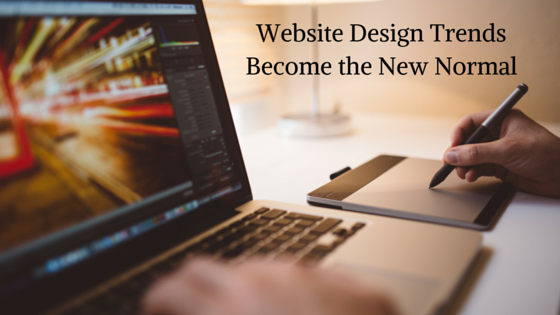Blog
Website Design Trends Become the New Normal
April 21, 2016
Posted by: DevDigital
In today’s technology-driven world, a website defines a company’s digital persona. A good website sets the framework for a company to develop and maintain positive relationships, while a bad website can have adverse effects on the company’s image. As companies strive to become more accessible online, there are certain trends that are becoming the new normal.
Many current web design trends stem from changes and adaptations in the typical user experience. As more people use their phones or other mobile devices to access websites, the design elements of these websites must consequentially adapt. Mobile access has become the new mainstream way of engaging with a website, thus the new trends in web design have adapted accordingly.
Website design trends fluctuate on a constant basis, but there are certain elements that have become so heavily utilized that they are becoming a new standard. These trends in web design often represent popular techniques and advancements in design that lead to efficiency.
From trend to best practice, the following traits are becoming the DNA of most successful websites:
- Responsive Web Design: As users increasingly access websites on their mobile devices, many companies are pursuing responsive design elements. Responsive Web Design (RWD) is an approach that focuses on the users’ preferences, environment, and behavior. RWD provides the best possible experience for users who use multiple devices to access a website. Responsive design has been heavily influenced by mobile usage increases and is becoming more of a best practice instead of merely just a trend.
- UX: Today, users expect some type of personalization: they’re looking for an experience that is predictive and anticipatory. The key to this is to make use of all the channels we have available to increase access to helpful information. This includes: better mobile notifications, more actionable emails, hyper-tailored content and recommendations, and doing things automatically for users (but always giving the user control to change). (UX Mag)
- Functionality over Aesthetic: Function is proving to be a more important focus than the appearance of a website. Don’t be mistaken—appearance still matters. However, functionality is the foundation upon which a good website is built. A website that effortlessly suits the needs of its users will always win over a good-looking website with limited functionality. However—the goal is to excel at both functionality and design aesthetic. Simple, functional, and speedy websites are becoming the new normal and most desired setups. The key is to develop attractive functionality.
- Material Design: The goal of Material Design is to create clean, modernistic design that focus on UX. While Google’s design aesthetic has detractors, it’s been mostly praised as a game-changer. With its minimalistic look, Material Design has a lot in common with another growing trend—flat design. Material Design, however, makes use of depth and shadow, which allows for more depth than pure flat design. (Source: Awwwards)
- Engaging Content: When establishing the appearance of a website, animation, infographics, and visual representations of data should be considered. These elements are visually appealing to users and often convey essential information to users. A good website should contain content that is simplified, yet intriguing and visually appealing. By utilizing engaging content in the form of visually attractive elements, a website is bound to gain and maintain the attention of the right users.
Ultimately, a website is a company’s best shot at garnering the right attention and converting its visitors into engaged (and paying) customers. A website is your best chance to say what you need to say while also catering to the needs of its visitors. By learning and adapting to these new trends, your website will stay ahead of the curve and be among those that are living out this new normal.
DevDigital’s team is ready to help you build or transform your website—contact us today to see how we can help you!
